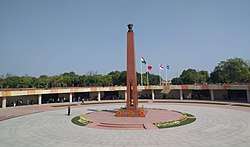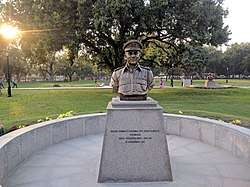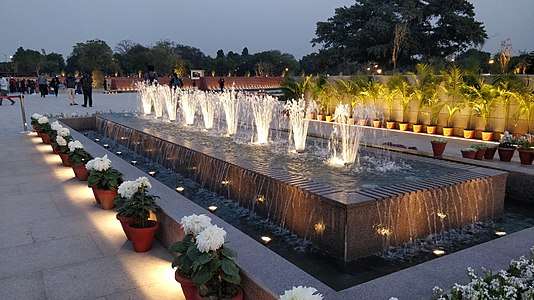National War Memorial (India)
The National War Memorial is a monument built by the Government of India near India Gate, New Delhi, to honour the Indian Armed Forces. The memorial is spread over 40 acres of land and is built around the existing chhatri (canopy) near India Gate.[1] The memorial wall is flushed with the ground and in harmony with existing aesthetics.[2] The names of armed forces personnel martyred during the armed conflicts of Indo-Pakistani War of 1947, 1961 War in Goa, Sino-Indian War, Indo-Pakistani War of 1965, Indo-Pakistani War of 1971, 1987 (Siachen), 1987-88 (Sri Lanka), 1999 (Kargil), and other operations such as Operation Rakshak, are inscribed on the memorial walls.[3]

%26groups%3D_21e979e0cc9ed27e19661a18aac29d560bb0b061.svg)
| |
| Established | 25 February 2019 |
|---|---|
| Location | India Gate Circle, New Delhi, India |
| Coordinates | 28°36′46″N 77°13′59″E |
| Type | Memorial |
| Architect | Yogesh Chandrahasan, WeBe Design Lab, Chennai |
| Website | Official government website of the National War Memorial |
A National War Museum will also be constructed in the adjoining Princess Park area. The Princess Park is a 14-acres large area north of India Gate, with barrack-like accommodations built during World War II. Since 1947, it has served as family accommodation for mid-level armed forces officers posted in the Service Headquarters in New Delhi.[4] The proposed National War Museum will be connected by metro. The construction of the War Memorial and Museum is expected to cost ₹500 crore (US$70 million).[5]

Architecture and design
A global design competition was conducted and the result was announced in early April 2017. A Chennai architectural firm, WeBe Design Lab's proposal was declared the winner and was accordingly chosen for the conceptualization of the architectural design and for coordinating the construction of the project.[6] The chief architect of the National War Memorial is Yogesh Chandrahasan of WeBe Design Lab, Chennai. Chandrahasan, who designed the project, said:[7]
“The whole concept is based on the thought that the war memorial should be a place where we don’t mourn the death, but celebrate the life of the soldiers and pay respect to the sacrifices made by them.”
The National War Memorial and Museum was designated as a Special Project, and the task of its "timely execution" was allocated to a Special Projects Division under the Chief Administrative Officer (Ministry of Defence), and the Military Engineer Services.[8]
The Memorial has four concentric circles and a central obelisk, at the bottom of which burns an 'eternal flame' representing the immortal soldier (amar jawan).[1][9] The concentric circles are called:
- Amar Chakra (Circle of Immortality)
- Veerta Chakra (Circle of Bravery)
- Tyag Chakra (Circle of Sacrifice)
- Rakshak Chakra (Circle of Protection)

These four concentric circles are designed as a Chakravyuh, an ancient Indian war formation.[10]
The Param Yodha Sthal houses the busts of the 21 recipients of the Param Vir Chakra, India's highest military honour.[1]
Timeline
- 1960 - The Indian Armed Forces first propose a national war memorial.[3]
- 2006 - In the face of persistent demand from the armed forces and veterans for a war memorial, the United Progressive Alliance (UPA) government constitutes a Group of Ministers' (headed by Pranab Mukherjee) to examine the demand.[11] In 2006, the Ministry of Defence decides that the war memorial should be set up in the vicinity of India Gate, but panels under the Ministry of Urban Development say that it is a heritage area and should not be built upon.[12]
- 20 October 2012 - After 50 years, the government marks the anniversary of the offensive by the Chinese People's Liberation Army against Indian border defences on 20 October 1962, by a solemn ceremony at the Amar Jawan Jyoti, to honour Indian soldiers killed in the 1962 war. At the ceremony, A. K. Antony (the Minister of Defence) announces that the government has conceded the long-standing demand of the Indian Armed Forces for a national war memorial, and that it will be built near India Gate. He adds that the group of ministers has cleared all outstanding issues on the matter and the armed forces will finally get their wish.[13][14] The Chief Minister of Delhi, Sheila Dikshit, opposes this plan.[11]
- February 2014 - In the build-up to the 2014 Lok Sabha elections, Narendra Modi speaks about how the previous government had failed to construct the war memorial.[15]
- 7 October 2015 - The Union Cabinet passes the proposal to build the war memorial. It also clears ₹500 crore for the memorial and museum, sanctioning ₹176 crore for the memorial alone.[16]
- May 2016 - The Union Cabinet is apprised of the decision taken by the Empowered Apex Steering Committee (EASC) that the Princess Park Complex would be the suitable site for construction of the National War Museum. The National War Memorial would be constructed at ‘C’ Hexagon of India Gate as approved by the Cabinet in its meeting held in October 2015.[17]
- 30 August 2016 - A global design competition for the National War Memorial and Museum is launched on the MyGov.in web portal.[18]
- April 2017 - The result of the global design competition is announced. Mumbai-based sP+a Studio's proposal wins for the design of the National War Museum. Chennai-based WeBe Design Lab's proposal is declared the winner for the design of the memorial.[15] A total of 427 submissions are received for the "Global Design Competition for National War Memorial" while 268 submissions are received for the "Global Architectural Competition for Indian National War Museum".[19][20] The jury was led by architect and planner Christopher Benninger.[1]
- 15 August 2018 - The National War Memorial misses the first deadline for its inauguration.[3]
- 1 January 2019 - The National War Memorial's construction is complete (not of the museum).[3][21]
- 25 February 2019 - The National War Memorial is inaugurated.[22]
- On 26 January 2020, the Prime Minister of India, Narendra Modi placed a wreath and observed 2 minutes silence to pay tribute to the soldiers before the start of the Republic Day Parade for the first time on Republic Day.
Gallery
 National war memorial with night lights
National war memorial with night lights.jpg) Floral decoration on the inauguration of the NWM
Floral decoration on the inauguration of the NWM A fountain at the NWM
A fountain at the NWM India Gate is visible in the background
India Gate is visible in the background India Gate from the Memorial
India Gate from the Memorial
See also
| Wikimedia Commons has media related to National War Memorial (India). |
- Amar Jawan Jyoti in New Delhi
- India Gate in New Delhi
- National Military Memorial in Bengaluru
- National War Memorial Southern Command in Pune
- Kargil Vijay Diwas
- Vijay Diwas (India)
- Bijoy Dibos
References
- Baruah, Sukrita (26 February 2019). "Explained: India's National War Memorial". The Indian Express. Retrieved 2 March 2019.
- Gokhale, Nitin A. (11 July 2014). "Fulfilling a sacred contract with the soldier". News Warrior. Retrieved 28 August 2014.
- Pandit, Rajat (1 January 2019). "Delhi: War memorial ready, 60 years after it was first proposed". The Times of India. Archived from the original on 3 January 2019. Retrieved 30 January 2019.
- "Budget 2014: India to finally get a national war memorial, Modi govt allocates Rs 100cr - Times of India". The Times of India. Retrieved 25 February 2019.
- "In Delhi, Army loses Lutyens territory; govt plans to build war museum, apartments in Princess Park - Economic Times". 21 January 2013. Retrieved 25 August 2014.
- https://thewire.in/urban/national-war-museum-delhi-india-gate
- Das Gupta, Moushumi (28 April 2018). "War memorial near India Gate to be completed by Independence Day". Hindustan Times. Retrieved 4 March 2019.
- "Charter of Duties". Ministry of Defence. Retrieved 22 November 2016.
- Siddiqui, Huma (25 February 2019). "National War Memorial: India's tribute to her war heroes, see stunning pics". The Financial Express. Retrieved 2 March 2019.
- Yadav, Namrata (3 March 2019). "Are you looking for someone you lost, Ma'am? They asked my mother at National War Memorial". The Print. Retrieved 4 March 2019.
- Nitin Gokhale (16 December 2012). "National war memorial - an unrealised dream". NDTV. Archived from the original on 28 August 2018. Retrieved 21 August 2014.
- P Sharma, Aruna (5 December 2006). "Ministry seeks new war memorial". Hindustan Times. Retrieved 30 January 2019.
- "In a first, nation pays homage to martyrs of 1962 Indo-China war". First Post. PTI. 20 October 2012. Retrieved 28 August 2014.
- http://www.newsx.com
- Bhatnagar, Gaurav Vivek (21 April 2018). "National War Memorial Takes Shape Six Decades After Being Conceived". The Wire. Archived from the original on 30 January 2019. Retrieved 30 January 2019.
- "Cabinet clears Rs. 500 crore for National War Memorial", The Hindu, 7 October 2015
- "Site for construction of National War Memorial and National War Museum - Press Information Bureau". Retrieved 27 August 2018.
- Press Information Bureau, Government of India, Ministry of Defence. "Global Design Competition for National War Memorial and Museum". Press Information Bureau. Archived from the original on 30 January 2019. Retrieved 30 January 2019.CS1 maint: multiple names: authors list (link)
- "Global Architectural Competition for Indian National War Museum". MyGov.in. 19 August 2016. Retrieved 30 January 2019.
- "Global Design Competition for National War Memorial". MyGov.in. 19 August 2016. Retrieved 30 January 2019.
- Alex Philip, Snehesh (7 January 2019). "National War Memorial to honour 22,600 soldiers set for R-Day eve inauguration". The Print. Retrieved 30 January 2019.
- Pandit, Rajat (3 February 2019). "National War Memorial to be finally inaugurated this month". The Times of India. Archived from the original on 3 February 2019. Retrieved 3 February 2019.